Electronic Device and Data Processing Method for Soil Resistivity Analysis
Abstract
:1. Introduction
2. Electronic Instrumentation
3. Design of the Experimental Soil Resistivity Platform
4. The Soil Resistivity Data Analysis Approach
5. Experimental Results
- Case 1: The aim of this first experiment was to detect a change from high to low resistivity by adding salty water to the aluminum container;
- Case 2: This experiment had the objective of measuring the change from high to medium resistivity by filling the aluminum container with sawdust;
- Case 3: The main objective of this scenario was to detect a resistivity change when the aluminum container was filled with cat litter.
5.1. Case 1: Experiment with Salty Water
5.2. Case 2: Experiment with Sawdust
5.3. Case 3: Experiment with Cat Litter
6. Conclusions
Author Contributions
Funding
Data Availability Statement
Conflicts of Interest
Abbreviations
| AC | Alternating current |
| DC | Direct current |
| EM | Electromagnetic |
| MLE | Maximum likelihood estimation method |
References
- Wenner, F. A Method of Measuring Earth Resistivity. Bull. Bur. Stand. 1916, 12, 469–478. [Google Scholar] [CrossRef]
- Samouelian, A.; Cousin, I.; Tabbagh, A.; Bruand, A.; Guy, R. Electrical resistivity survey in soil science: A review. Soil Tillage Res. 2005, 83, 173–193. [Google Scholar] [CrossRef] [Green Version]
- Loke, M.H.; Chambers, J.E.; Kuras, O. Instrumentation, electrical resistivity. Encycl. Solid Earth Geophys. 2011, 1, 599–604. [Google Scholar]
- Igboama, W.N.; Ugwu, N.U. Fabrication of resistivity meter and its evaluation. Am. J. Sci. Ind. Res. 2011, 2, 713–717. [Google Scholar]
- Chen, T.T.; Hung, Y.C.; Hsueh, M.W.; Yeh, Y.H.; Weng, K.W. Evaluating the Application of Electrical Resistivity Tomography for Investigating Seawater Intrusion. Electronics 2018, 7, 107. [Google Scholar] [CrossRef] [Green Version]
- Bodh, R.; Shrivastava, P.; Shrivastava, S. Application of Schlumberger Method for Characterization of Soil. Int. J. Innov. Technol. Explor. Eng. 2019, 8. [Google Scholar] [CrossRef]
- Han, Y.; Yang, W.; Li, M.; Meng, C. Comparative Study of Two Soil Conductivity Meters Based on the Principle of Current-Voltage Four-Terminal Method. IFAC-PapersOnLine 2019, 52, 36–42. [Google Scholar] [CrossRef]
- Kaminskyj, R.; Shakhovska, N.; Michal, G.; Ladanivskyy, B.; Savkiv, L. An Express Algorithm for Transient Electromagnetic Data Interpretation. Electronics 2020, 9, 354. [Google Scholar] [CrossRef] [Green Version]
- Ramos-Leanos, O.; Uribe, F.; Valcárcel, L.; Hajiaboli, A.; Franiatte, S.; Dawalibi, F. Nonlinear Electrode Arrangements for Multilayer Soil Resistivity Measurements. IEEE Trans. Electromagn. Compat. 2020, 62, 2148–2155. [Google Scholar] [CrossRef]
- Huda, E.; Yohandri, E. Development of an automatic multi-electrode digital resistivity meter for the Schlumberger configuration. Pillar Phys. 2020, 13, 74–81. [Google Scholar]
- Petrache, E.; Dick, E.; Jamali, B.; Chisholm, W. Soil Resistivity Testing; CEATI Report T113700-3702; CEATI International: Montreal, QC, Canada, 2014. [Google Scholar]
- Southey, R.; Siahrang, M.; Fortin, S.; Dawalibi, F. Using Fall-of-Potential Measurements to Improve Deep Soil Resistivity Estimates. IEEE Trans. Ind. Appl. 2015, 51, 5023–5029. [Google Scholar] [CrossRef]
- Permal, N.; Osman, M.; Kadir, M.Z.A.A.; Ariffin, A. Review of Substation Grounding System Behavior Under High Frequency and Transient Faults in Uniform Soil. IEEE Access 2020, 8, 142468–142482. [Google Scholar] [CrossRef]
- Supandi, S. Geotechnical profiling of a surface mine waste dump using 2D Wenner–Schlumberger configuration. Open Geosci. 2021, 13, 335–344. [Google Scholar] [CrossRef]
- Sophocleous, M. Electrical Resistivity Sensing Methods and Implications. Electr. Resist. Conduct. 2017, 5, 67748. [Google Scholar]
- Unal, I.; Kabas, O.; Sozer, S. Real-Time Electrical Resistivity Measurement and Mapping Platform of the Soils with an Autonomous Robot for Precision Farming Applications. Sensors 2020, 20, 251. [Google Scholar] [CrossRef] [PubMed] [Green Version]
- Gruzdev, A.; Bobachev, A.; Shevnin, V. Determining the Field of Application of the Noncontact Resistivity Technique. Mosc. Univ. Geol. Bull. 2020, 75, 644–651. [Google Scholar] [CrossRef]
- Sudduth, K.; Kitchen, N.; Bollero, G.; Bullock, D.; Wiebold, W. Comparison of electromagnetic induction and direct sensing of soil electrical conductivity. Agron. J. 2003, 95, 472–482. [Google Scholar] [CrossRef]
- Lueck, E.; Ruehlmann, J. Resistivity Mapping with GEOPHILUS ELECTRICUS—Information about Lateral and Vertical Soil Heterogeneity. Geoderma 2013, 199, 2–11. [Google Scholar] [CrossRef]
- Rashid, M. Power Electronics: Circuits, Devices, and Applications, 3rd ed.; Pearson: London, UK, 2003. [Google Scholar]
- Franco, S. Design with Operational Amplifiers and Analog Integrated Circuits, 2nd ed.; McGraw-Hill: New York, NY, USA, 2002. [Google Scholar]
- Archie, G. The electric resistivity log as an aid in determining some reservoir characteristics. Trans. Am. Inst. Min. Metall. Pet. Eng. 1942, 146, 54–62. [Google Scholar]
- Zhou, M.; Wang, J.; Cai, L.; Fan, Y.; Zheng, Z. Laboratory Investigations on Factors Affecting Soil Electrical Resistivity and the Measurement. IEEE Trans. Ind. Appl. 2015, 51, 5358–5365. [Google Scholar] [CrossRef]
- Datsios, Z.; Mikropoulos, P.; Karakousis, I. Laboratory characterization and modeling of DC electrical resistivity of sandy soil with variable water resistivity and content. IEEE Trans. Dielectr. Electr. Insul. 2017, 24, 3063–3072. [Google Scholar] [CrossRef]
- Roodposhti, H.; Hafizi, M.; Kermani, M.; Nik, M. Electrical resistivity method for water content and compaction evaluation, a laboratory test on construction material. J. Appl. Geophys. 2019, 168, 49–58. [Google Scholar] [CrossRef]
- Kouchaki, B.; Bernhardt-Barry, M.; Wood, C.; Moody, T.A. Laboratory Investigation of Factors Influencing the Electrical Resistivity of Different Soil Types. Geotech. Test. J. 2019, 42, 829–853. [Google Scholar] [CrossRef]
- Adla, S.; Rai, N.; Sri Karumanchi, H.; Tripathi, S.; Disse, M.; Pande, S. Laboratory Calibration and Performance Evaluation of Low-Cost Capacitive and Very Low-Cost Resistive Soil Moisture Sensors. Sensors 2020, 20, 363. [Google Scholar] [CrossRef] [Green Version]
- Benjamin, J.; Cornell, C. Probability, Statistics, and Decision for Civil Engineers; McGraw-Hill: New York, NY, USA, 2014. [Google Scholar]
- Mood, A.; Graybill, F. Introduction to the Theory of Statistics; McGraw-Hill: New York, NY, USA, 1963. [Google Scholar]

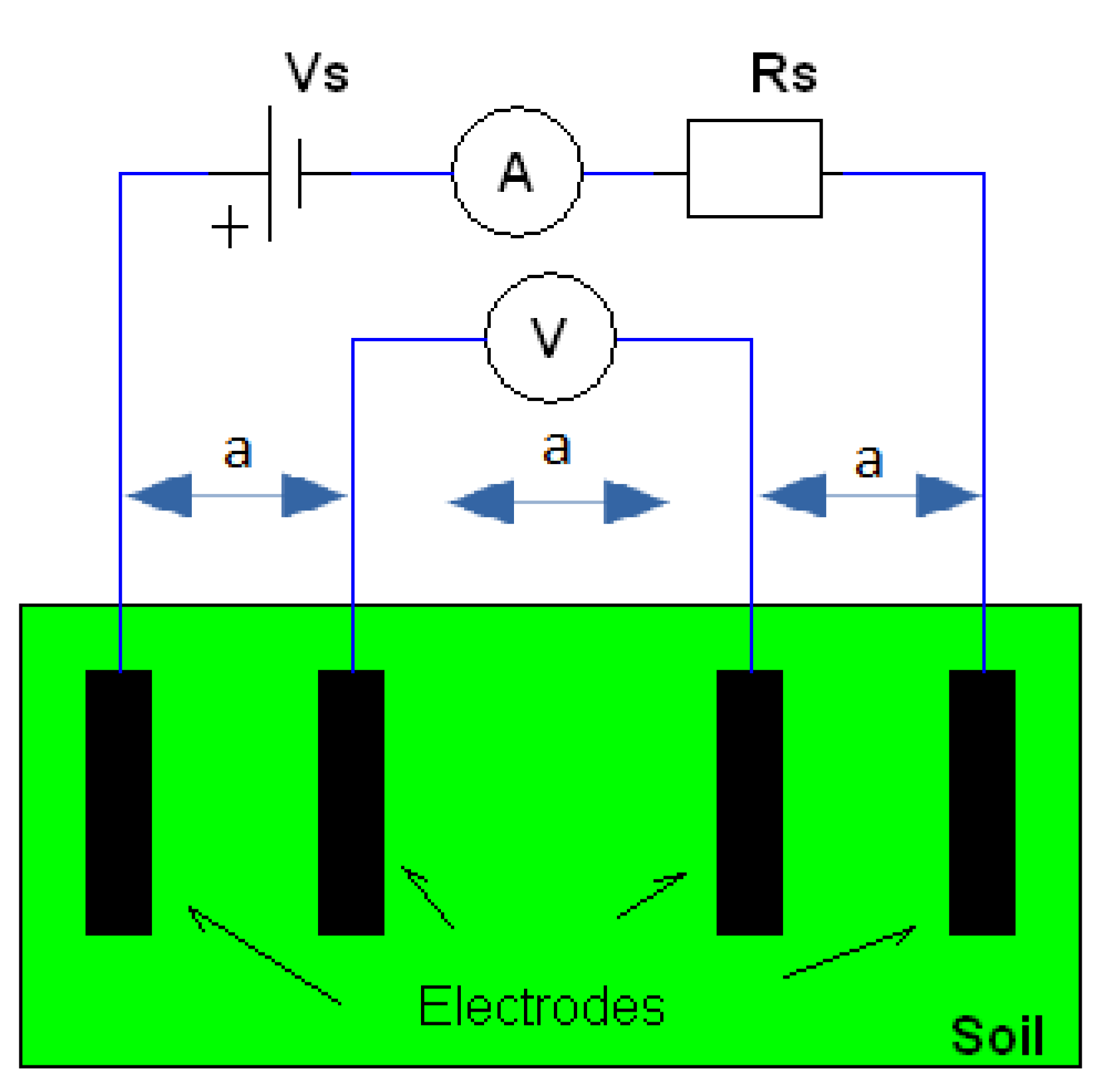

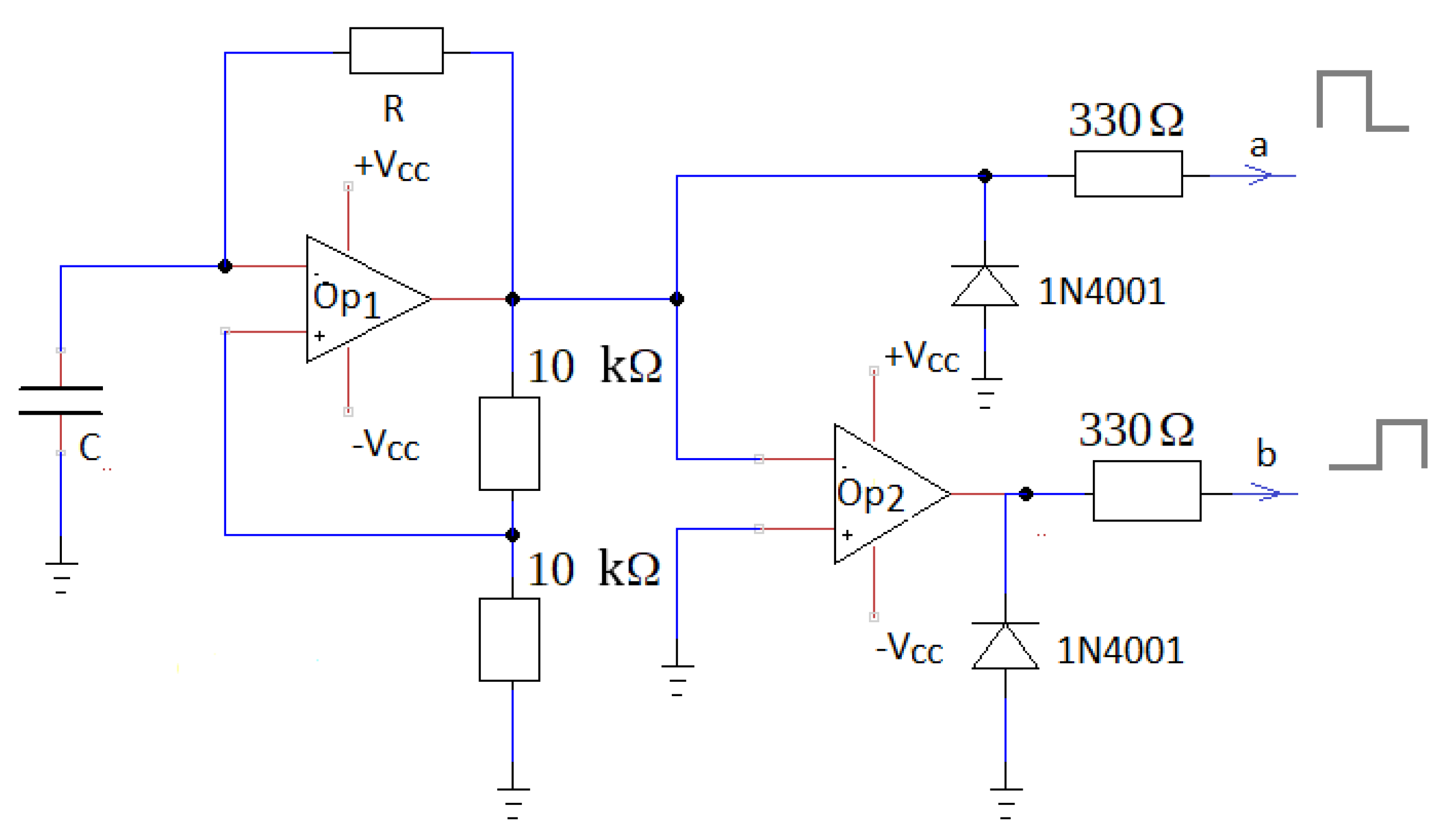

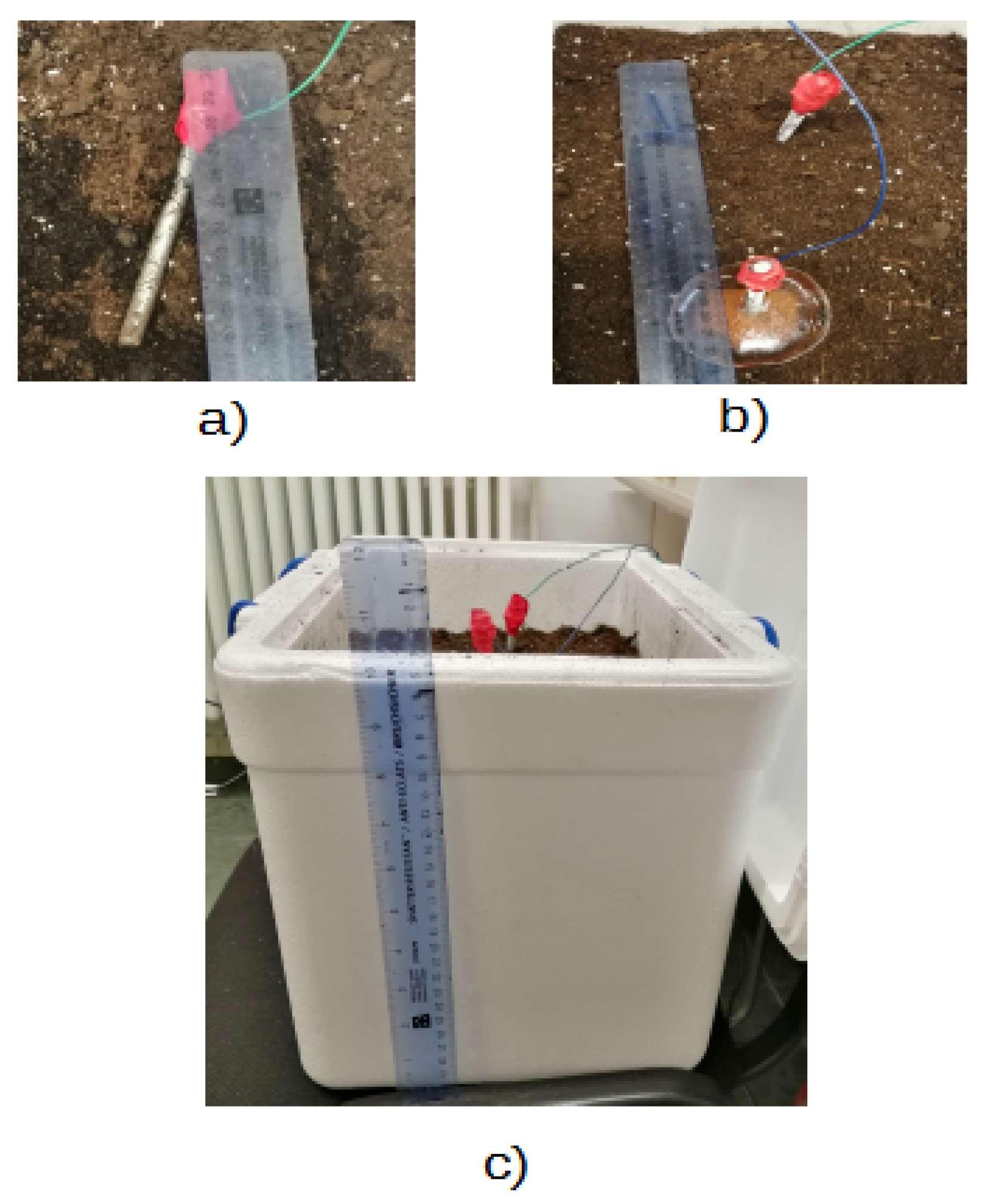


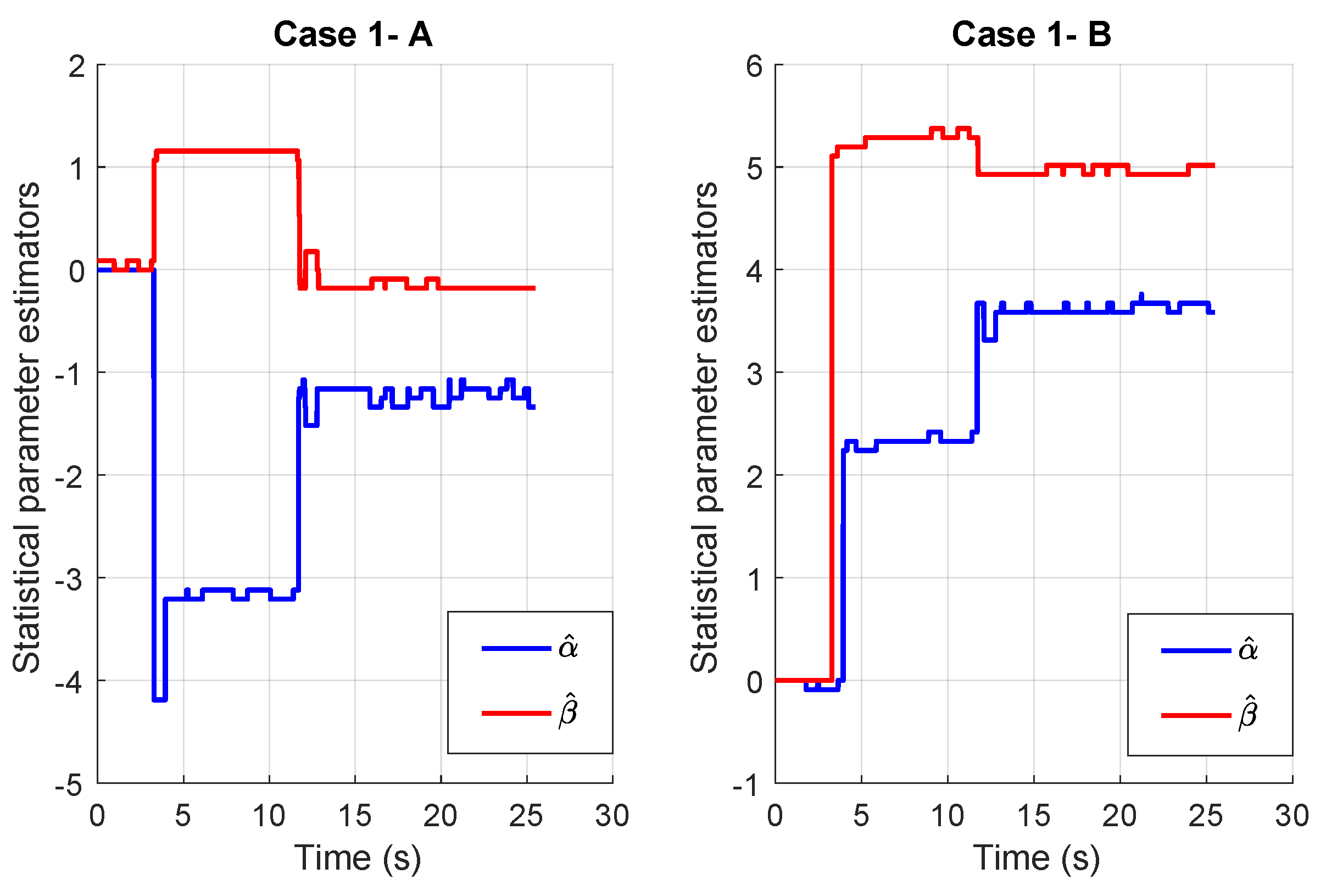
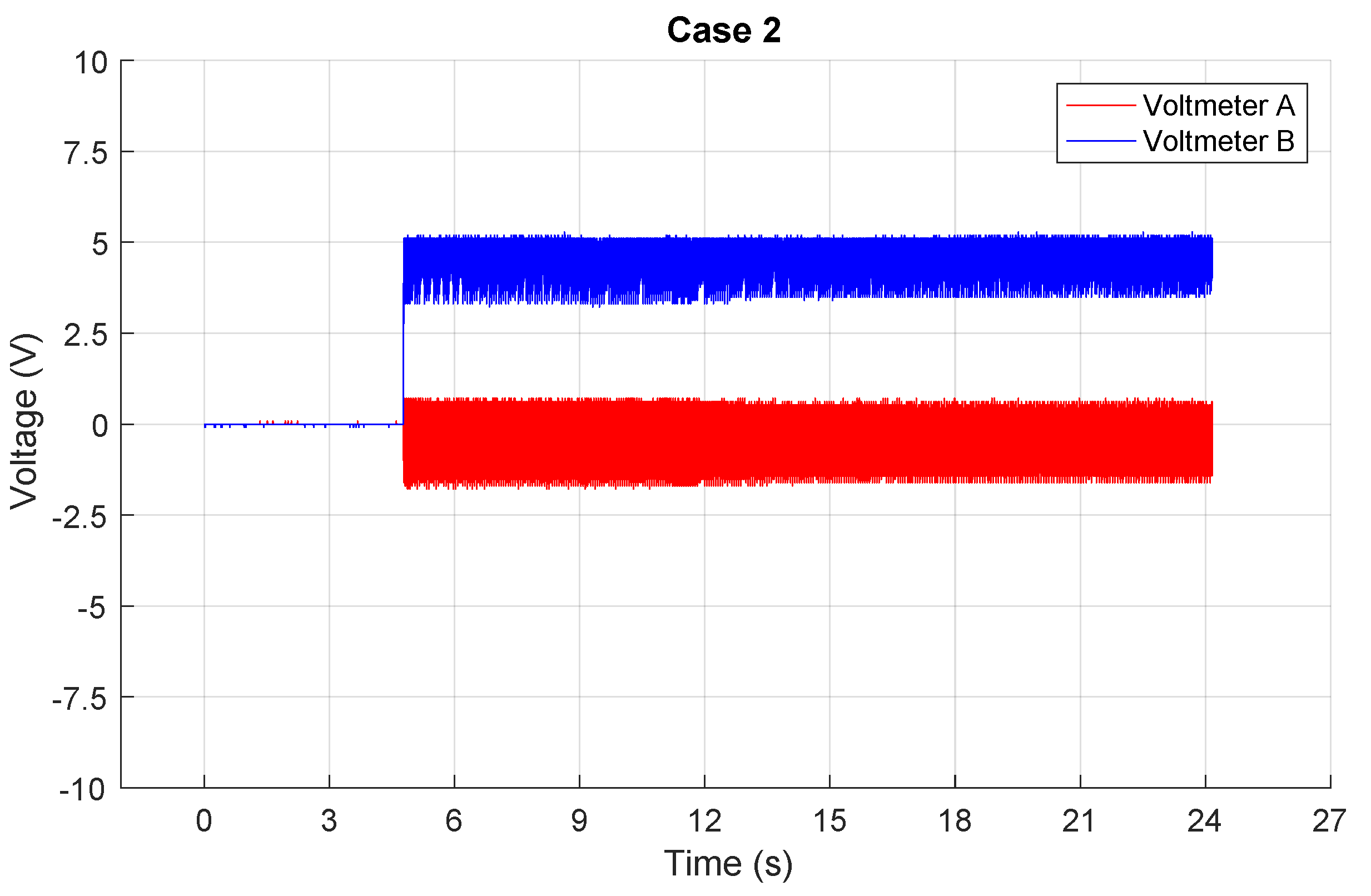
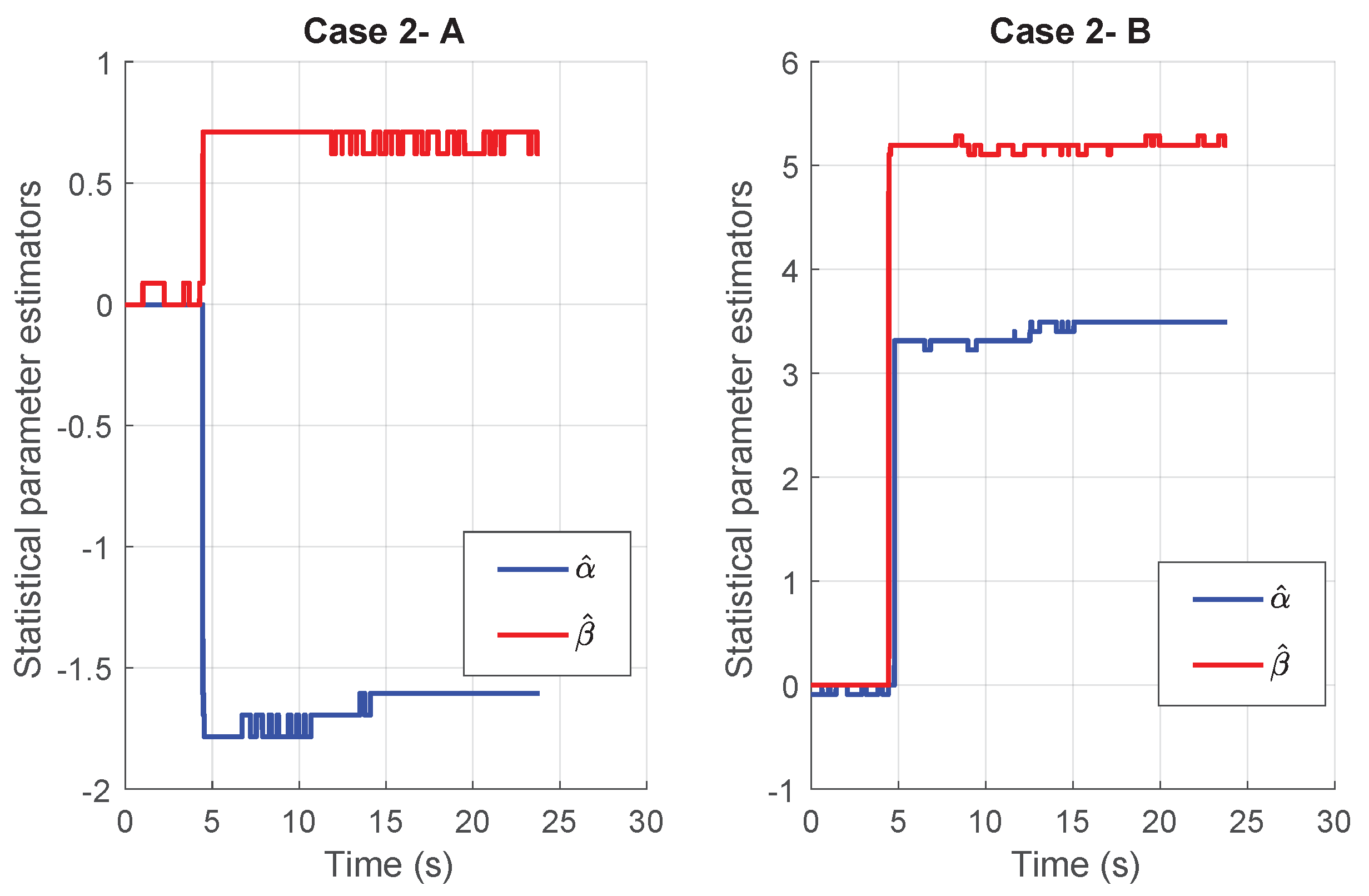
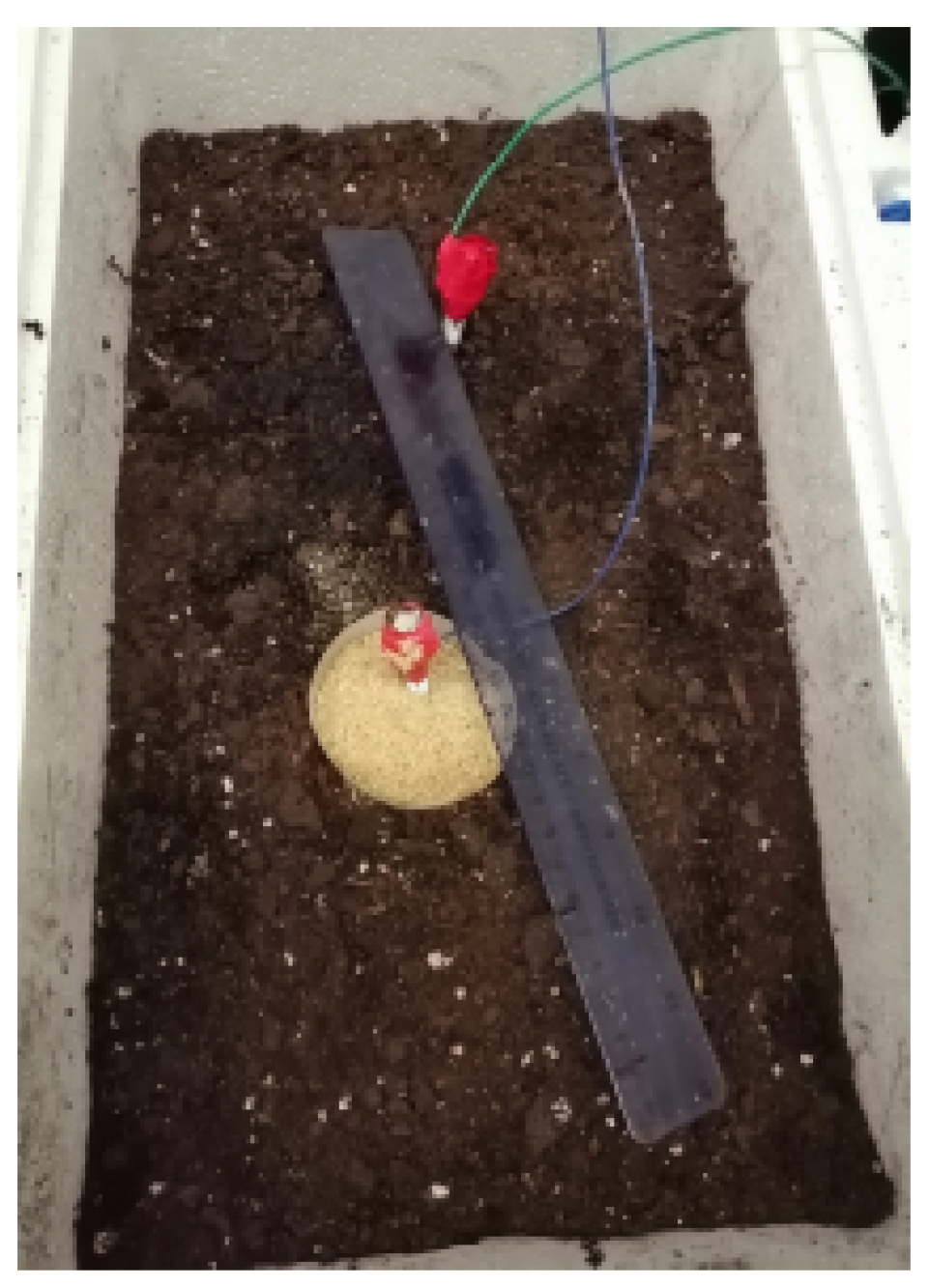
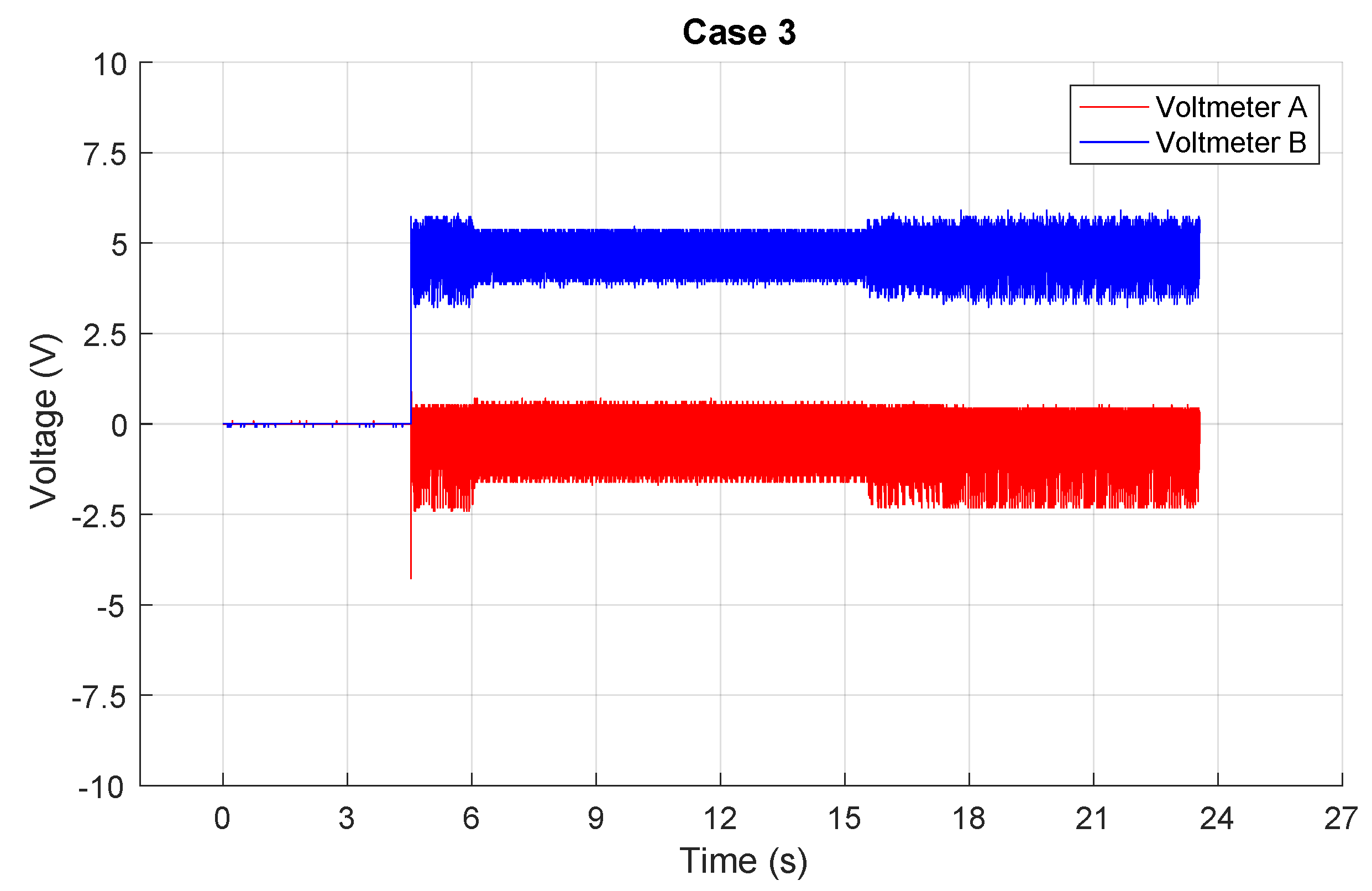
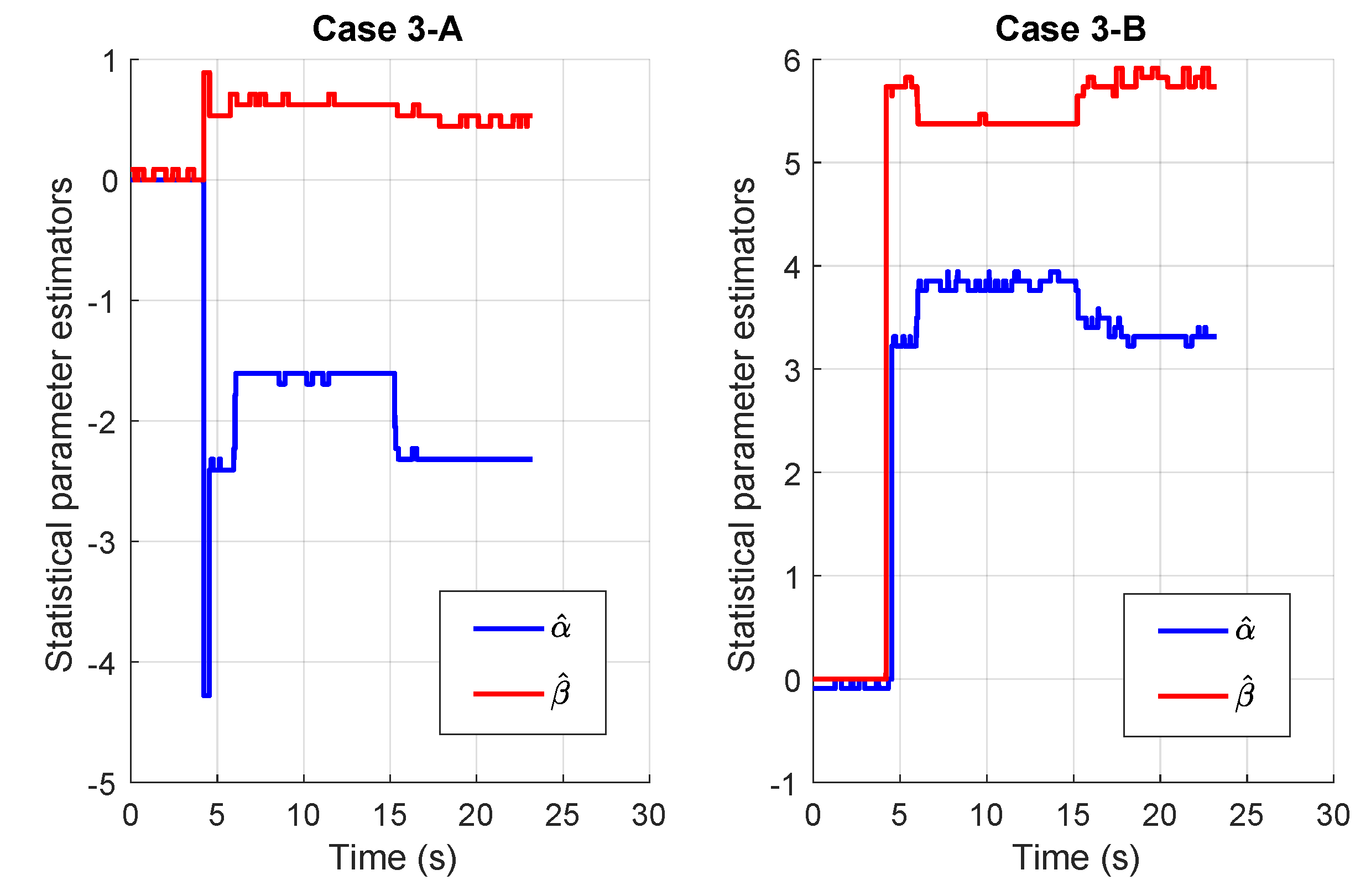

Publisher’s Note: MDPI stays neutral with regard to jurisdictional claims in published maps and institutional affiliations. |
© 2021 by the authors. Licensee MDPI, Basel, Switzerland. This article is an open access article distributed under the terms and conditions of the Creative Commons Attribution (CC BY) license (https://creativecommons.org/licenses/by/4.0/).
Share and Cite
Acho, L.; Pujol-Vázquez, G.; Gibergans-Báguena, J. Electronic Device and Data Processing Method for Soil Resistivity Analysis. Electronics 2021, 10, 1281. https://doi.org/10.3390/electronics10111281
Acho L, Pujol-Vázquez G, Gibergans-Báguena J. Electronic Device and Data Processing Method for Soil Resistivity Analysis. Electronics. 2021; 10(11):1281. https://doi.org/10.3390/electronics10111281
Chicago/Turabian StyleAcho, Leonardo, Gisela Pujol-Vázquez, and José Gibergans-Báguena. 2021. "Electronic Device and Data Processing Method for Soil Resistivity Analysis" Electronics 10, no. 11: 1281. https://doi.org/10.3390/electronics10111281
APA StyleAcho, L., Pujol-Vázquez, G., & Gibergans-Báguena, J. (2021). Electronic Device and Data Processing Method for Soil Resistivity Analysis. Electronics, 10(11), 1281. https://doi.org/10.3390/electronics10111281







